How to Set Up Base Camp for Island Peak Climbing?
Welcome to our comprehensive guide on setting up a base camp for island peak climbing! If you’re planning an exhilarating expedition to conquer the majestic Island Peak, you know that a well-established base camp is vital for your safety, comfort, and success.
In this article, we will walk you through the essential steps and considerations to create a secure and efficient base camp specifically designed for island peak climbing.
Whether you’re a seasoned mountaineer or embarking on your first high-altitude adventure, mastering the art of setting up a base camp for island peak climbing will ensure you have a solid foundation for your remarkable journey.
So, let’s dive in and explore the crucial aspects of establishing a base camp that will serve as your sanctuary amidst the awe-inspiring Himalayan landscapes.
Table of Contents
Importance of a well-established base camp for island peak climbing
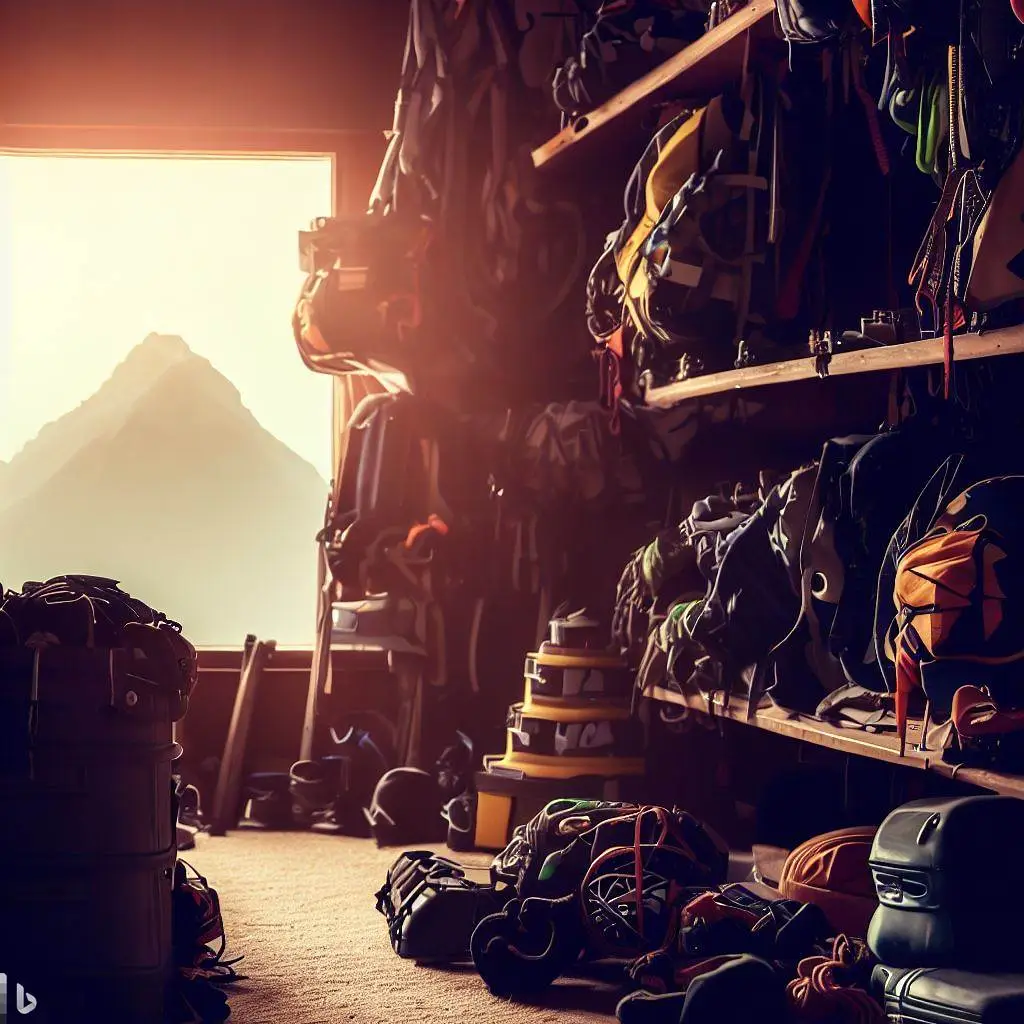
When embarking on an island peak climbing expedition, a well-established base camp serves as the central hub for climbers.
It provides a secure and comfortable environment where they can rest, properly acclimatize, and prepare for the challenging ascent. The significance of a well-established base camp can be summarized as follows:
Safety: A properly set up base camp acts as a sanctuary for climbers, offering protection from unpredictable weather conditions and potential hazards. It serves as a retreat in case of emergencies and provides a sense of security throughout the expedition.
Acclimatization: Island peak climbing requires climbers to adapt to high-altitude environments. A well-established base camp allows for gradual acclimatization, reducing the risk of altitude sickness, and difficulty of Island Peak Climbing and increasing the chances of a successful summit.
Equipment Organization: Base camps serve as a base of operations where climbers can store and organize their equipment. By having a well-structured campsite, climbers can easily locate and access the necessary gear, ensuring efficiency and readiness during the climb.
Enhancing Safety and Comfort Through Proper Base Camp Setup
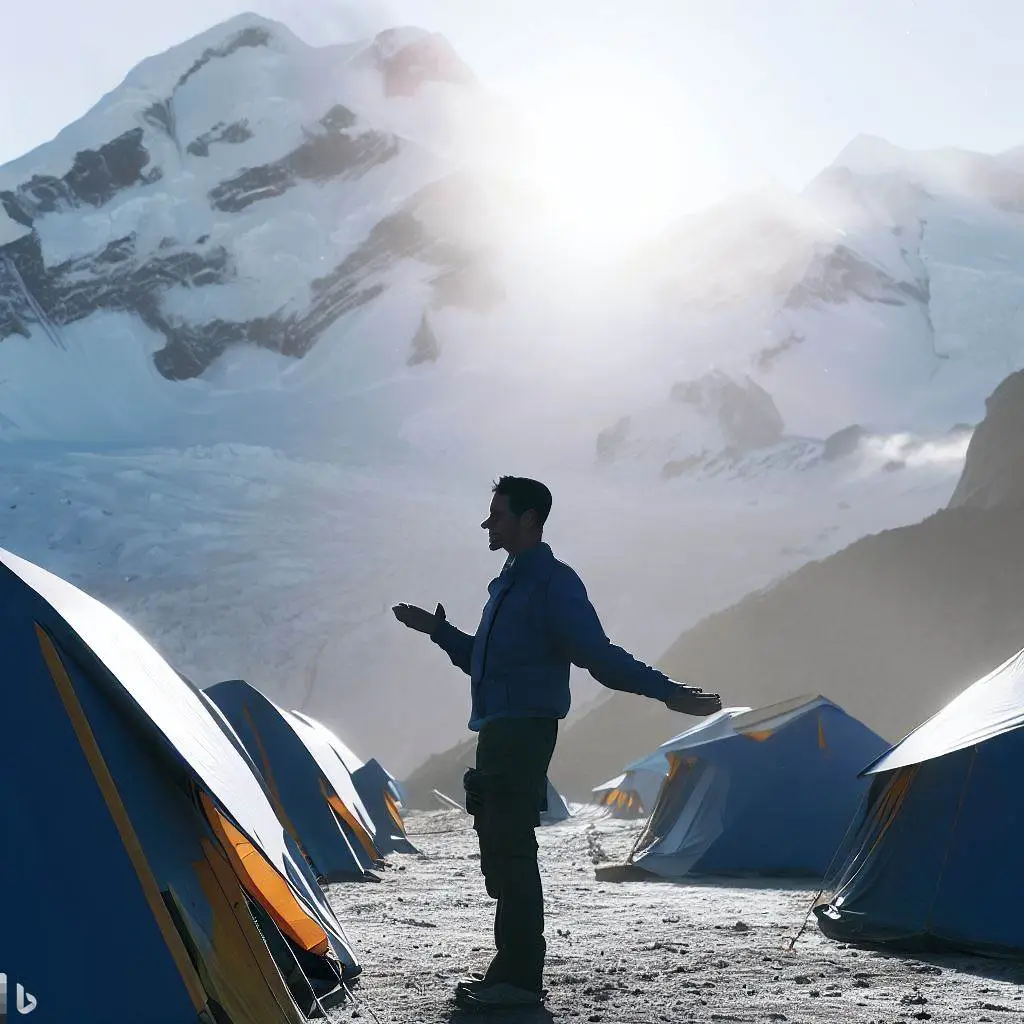
- Campsite Selection: Choosing an optimal location for the base camp is vital. Factors to consider include proximity to shelter from wind and avalanches and flat terrain for tents. Conducting thorough research and consulting experienced climbers can help identify suitable campsite locations. Nepal Peak Adv guides are well-experienced in campsite selection.
- Tent Setup: Properly setting up tents is essential for protection against the elements. Securely anchoring the tents and utilizing waterproof materials can prevent damage and keep climbers dry and comfortable.
- Cooking and Dining Area: Creating a designated area for cooking and dining enhances the overall camping experience. Setting up a safe and efficient cooking space ensures proper food preparation, and having a comfortable dining area promotes camaraderie among climbers.
- Sanitation Facilities: Establishing proper sanitation facilities, such as toilets and waste disposal systems, is crucial to maintaining hygiene and preserving the environment. Following Leave No Trace principles is essential in preserving the natural beauty of the island peak region.
Selecting the Base Camp Location
Factors to consider when choosing a suitable base camp location
- Shelter from wind and avalanches: Considering the unpredictable mountain weather, it is crucial to choose a base camp location that offers natural or man-made shelter from strong winds and potential avalanches. This provides a safer and more comfortable environment for climbers.
- Accessibility to other necessary locations (e.g., climbing route, kitchen area): The chosen base camp location should have convenient access to other important areas, such as the climbing route and kitchen area. This facilitates efficient movement and organization within the camp, saving time and effort for climbers.
See what Island Peak Climbing Map looks like.
Setting Up Tents for Peak Climbing
- Choosing appropriate tents for base camp
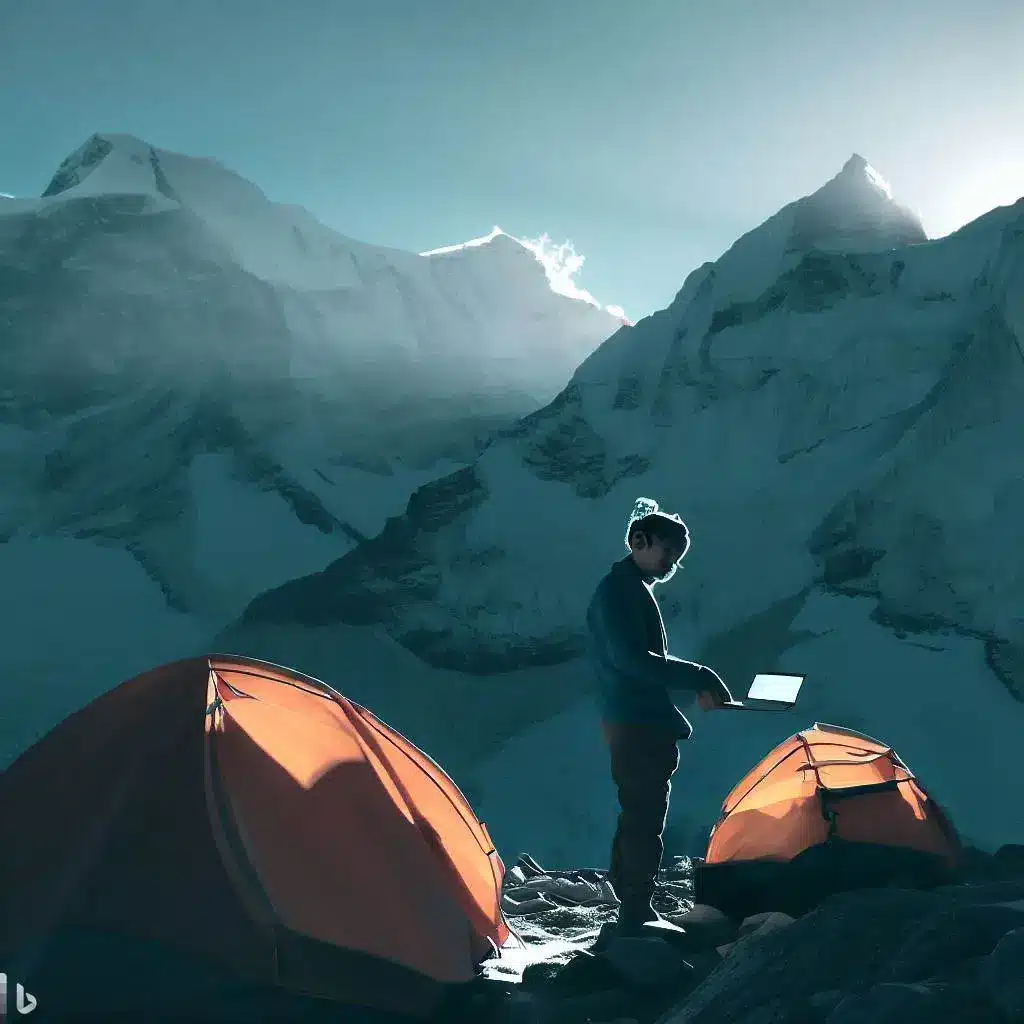
When setting up base camp for island peak climbing, selecting the right tents is crucial for providing shelter and ensuring a comfortable stay. Consider the following factors when choosing appropriate tents for Island Peak Climbing:
- Size and Capacity: Opt for tents that can comfortably accommodate the anticipated number of climbers and their gear. It is essential to have enough space for sleeping, storing equipment, and moving around inside the tent.
- Durability and Weather Resistance: Base camp tents should be sturdy and able to withstand various weather conditions, including strong winds, rain, and snow. Look for tents made from durable materials and equipped with reliable waterproofing features.
- Weight and Portability: Since climbers need to transport their tents to the base camp, lightweight and compact tents are preferred. This makes carrying them easier and more manageable during the trek.
Steps for setting up tents effectively
To ensure a successful tent set up at the base camp, follow these steps:
1. Clearing the ground and removing debris: Before pitching the tents, clear the area of any rocks, branches, or other debris that could cause discomfort or damage the tent floor. Smooth out the ground as much as possible for a comfortable sleeping surface.
2. Tent placement and orientation: Choose a flat and level spot for each tent. Consider the direction of prevailing winds and orient the tents accordingly to minimize exposure to gusts. Additionally, position the tent entrances away from potential runoff areas or hazards.
3. Anchoring the tents securely: Use stakes or other suitable anchoring methods to secure the tent to the ground. Ensure the tent is taut and properly tensioned to withstand wind and prevent flapping noises during the night.
4. Ensuring proper ventilation and insulation: Proper airflow is essential to prevent condensation buildup inside the tent. Open vents or windows to allow fresh air circulation while maintaining privacy. Additionally, use insulating mats or ground covers to provide insulation from the cold ground.
By carefully selecting appropriate tents and following these steps for setting them up effectively, climbers can establish a comfortable and secure base camp for their island peak climbing expedition. Similarly, you should also know which is the best time for Island Peak Climbing for a safe experience.
Establishing a Kitchen Area
- Importance of a dedicated kitchen area in base camp
A well-established kitchen area is crucial for a successful base camp during island peak climbing. It provides a dedicated space for preparing meals, promoting efficient cooking practices, and maintaining hygiene standards. The importance of a dedicated kitchen area includes:
- Organization: Having a designated kitchen area allows for better organization of cooking equipment, utensils, and food supplies. This ensures that everything is easily accessible when needed, saving time and effort.
- Safety: By centralizing cooking activities in one area, potential hazards such as open flames and hot surfaces can be properly managed. It reduces the risk of accidents and helps maintain a safe environment for climbers.
- Hygiene: A separate kitchen area allows for proper food handling and sanitation practices. It helps prevent cross-contamination and ensures that food is prepared in a clean and controlled environment, reducing the chances of foodborne illnesses.
Steps for setting up the kitchen area
To establish an efficient and functional kitchen area at the base camp, follow these steps:
1. Organizing cooking equipment and supplies: Arrange cooking equipment, utensils, and food supplies in a logical and systematic manner. Use containers or shelves to keep items organized and easily accessible. Consider implementing color-coding or labeling systems for efficient storage.
2. Setting up cooking stoves and fuel storage: Install cooking stoves in a well-ventilated area, away from flammable materials. Ensure proper fuel storage and adhere to safety guidelines for handling and storing fuels. Maintain a safe distance between cooking areas and fuel storage to prevent accidents.
3. Implementing proper waste management practices: Establish a waste management system to maintain cleanliness and minimize environmental impact. Use separate containers for food waste, recyclables, and non-recyclable waste. Regularly empty and dispose of the waste following local regulations or guidelines.
Safety Considerations
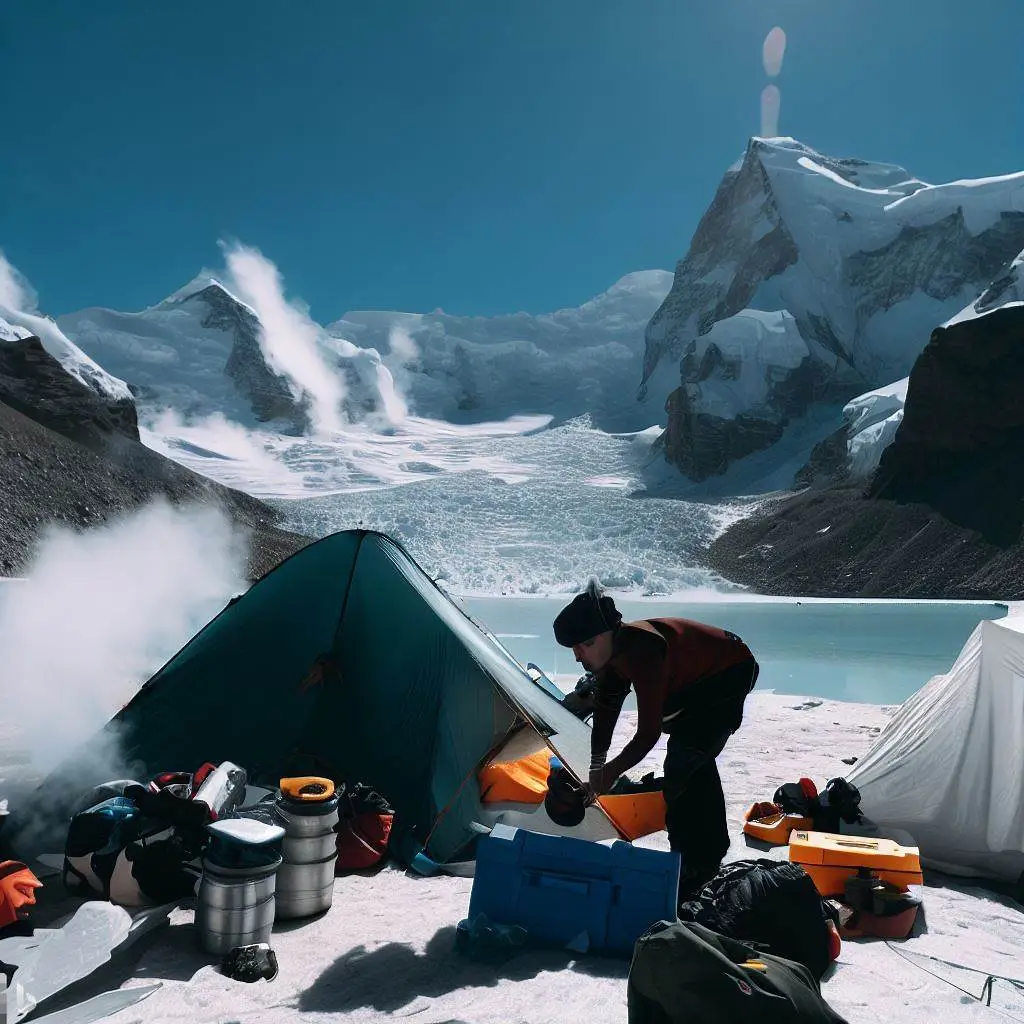
Implementing measures to enhance safety at base camp
Ensuring the safety of climbers and their belongings is of utmost importance at the base camp during island peak climbing. Implementing specific measures can significantly enhance safety. Consider the following steps:
- Establishing Emergency Protocols: Develop clear and well-communicated emergency protocols for various scenarios that may arise at the base camp. This includes protocols for medical emergencies, severe weather conditions, and communication failures. Educate all team members about these protocols to ensure a coordinated response in case of emergencies.
- Securing the Camp Against Wildlife and Theft: Take proactive measures to protect the base camp from wildlife encounters and potential theft. Store food supplies in bear-resistant containers or hang them from elevated structures to deter wildlife. Implement security measures such as locks and surveillance systems to prevent unauthorized access and theft of valuable equipment.
Storing and Managing Climbing Gear and Equipment
Proper storage and management of climbing gear and equipment are crucial for safety and longevity. Consider the following guidelines:
Organized Gear Storage: Designate specific areas or containers for storing different types of climbing gear, such as ropes, harnesses, helmets, and carabiners. Keep the gear organized and easily accessible to prevent loss or damage.
Inspection and Maintenance: Regularly inspect climbing gear and equipment for signs of wear and tear, such as frayed ropes or malfunctioning carabiners. Replace or repair any damaged gear to maintain its reliability and ensure the safety of climbers during the expedition.
Secure Storage: Use lockable storage containers or lockers to safeguard valuable climbing gear when not in use. This helps prevent theft and ensures that the gear remains in optimal condition.
Drying and Ventilation: After each use, properly dry wet gear to prevent mold or mildew growth, which can compromise its integrity. Ensure adequate ventilation in storage areas to minimize moisture buildup and maintain gear quality.
Ensuring proper communication and emergency contact systems
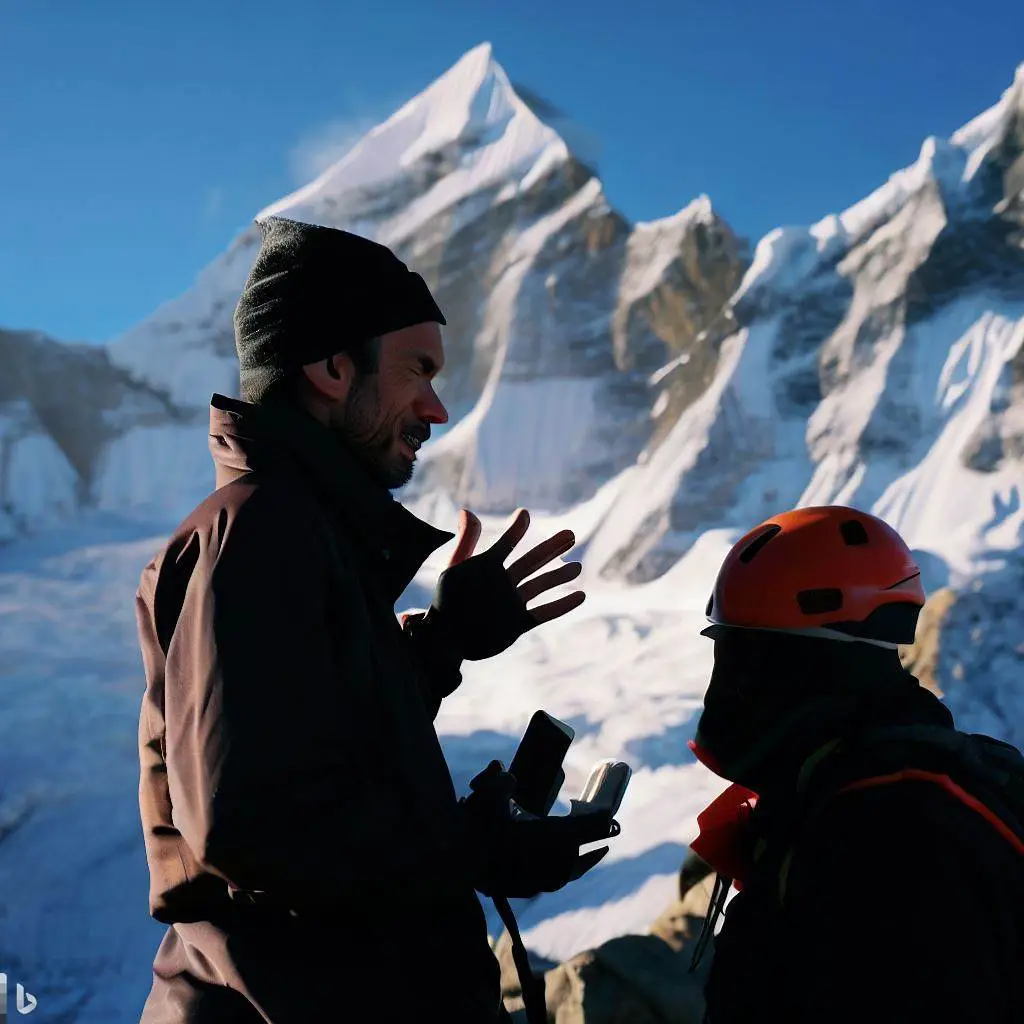
Effective communication and reliable emergency contact systems are essential for maintaining safety and facilitating timely assistance during island peak climbing expeditions. Here are key considerations to ensure proper communication and emergency contact systems at the base camp:
Establishing Communication Protocols: Define clear communication protocols for all team members at the base camp. This includes establishing designated communication times, channels, and frequencies. Ensure that everyone understands and follows these protocols to maintain regular contact and facilitate efficient communication.
Carrying Communication Devices: Equip team members with reliable communication devices, such as two-way radios or satellite phones, to enable real-time communication. These devices should have sufficient battery life and be tested before the expedition to ensure they are in working order. It is also important to have backup communication options in case of device failure.
Emergency Contact Information: Maintain a list of emergency contact information for each team member, including their next of kin, local authorities, and medical services. Distribute this information to all team members and keep a copy at the base camp. In case of emergencies, this information will facilitate quick communication and appropriate actions.
Establishing Check-In Procedures: Implement regular check-in procedures to track the whereabouts and well-being of team members. Set specific check-in times and locations to ensure that everyone is accounted for and identify any potential issues or delays.
Emergency Signaling: Establish emergency signaling methods, such as whistle blasts or designated hand signals, to quickly communicate distress or urgent situations. Educate all team members about these signals to ensure effective communication in emergency scenarios.
Training and Education: Provide training to team members on proper communication procedures and emergency protocols. This includes educating them on the use of communication devices, emergency signaling, and how to report and respond to emergencies.
Testing Communication Systems: Before the expedition, thoroughly test all communication systems and devices to ensure they are functioning correctly. Conduct range tests for two-way radios and satellite phone connections to identify any potential limitations or dead zones in communication coverage.
Conclusion
Final tips and reminders for maintaining and managing the base camp effectively
As you embark on your island peak climbing expedition, it is crucial to remember some final tips and reminders for maintaining and managing the base camp effectively. These guidelines will help ensure a smooth and successful experience throughout your journey. Here are some key points to consider:
Regular Maintenance: Schedule regular maintenance tasks to keep the base camp in optimal condition. This includes checking and repairing tents, inspecting cooking equipment, and monitoring the overall camp infrastructure. By addressing any issues promptly, you can prevent them from escalating into larger problems that may disrupt your expedition.
Hygiene and Cleanliness: Maintain high standards of hygiene and cleanliness at the base camp to promote good health and prevent the spread of illnesses. Establish proper waste management practices, including waste disposal and recycling methods. Encourage all team members to follow responsible hygiene practices, such as handwashing and proper waste disposal, to keep the camp environment clean and sanitary.
Respect for the Environment: Practice responsible and eco-friendly camping techniques to minimize your impact on the natural surroundings. Adhere to Leave No Trace principles by leaving the campsite as you found it, disposing of waste properly, and avoiding damage to vegetation and wildlife habitats. Respect the local flora and fauna, and be mindful of any sensitive ecological areas near the base camp.
Teamwork and Cooperation: Foster a spirit of teamwork and cooperation among all team members. Encourage open communication, mutual support, and shared responsibilities. Collaborate on tasks such as camp setup, maintenance, and daily chores. By working together harmoniously, you can create a positive and efficient camp environment.
Flexibility and Adaptability: Be prepared to adapt to changing circumstances and weather conditions. Island peak climbing expeditions can be unpredictable, so it is important to remain flexible in your plans and adjust accordingly. Stay informed about weather forecasts and be ready to modify your schedule or activities if necessary for safety reasons.
Enjoy the Journey: While it is important to prioritize safety and efficiency at the base camp, remember to enjoy the journey and appreciate the unique experience of island peak climbing. Take the time to soak in the breathtaking scenery, connect with fellow climbers, and savor the sense of accomplishment as you make progress toward your goal.
By keeping these final tips and reminders in mind, you can maintain and manage the base camp effectively, ensuring a successful and memorable island peak climbing expedition. Stay organized, respect the environment, support your team members, and embrace the adventure that awaits you. Best of luck with your climbing endeavor!
Also, check out some more information about Island Peak Climbing Cost, Island Peak Climbing Itinerary, rules and gidelines, and many more.



